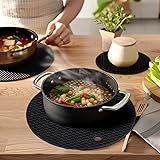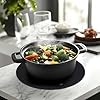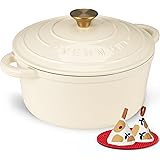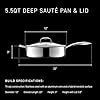Silicone Trivet Mats,Heat Resistant Pot Holders, Multipurpose Non-Slip Hot Pads for Kitchen Potholders, Hot Dishers, Jar Opener, Spoon Holder, Food Grade Silicone(Black Size Round 7''x7'')
$1.96 (as of December 7, 2025 11:17 GMT -05:00 - More infoProduct prices and availability are accurate as of the date/time indicated and are subject to change. Any price and availability information displayed on [relevant Amazon Site(s), as applicable] at the time of purchase will apply to the purchase of this product.)Overmont Enameled Cast Iron Dutch Oven - 5.5QT Pot with Lid Cookbook & Cotton Potholders - Heavy-Duty Cookware for Braising, Stews, Roasting, Bread Baking Cream White
14% OffHexClad Hybrid Nonstick 5.5-Quart Deep Sauté Pan with Tempered Glass Lid, Stay-Cool Handle, Dishwasher-Friendly, Oven-Safe Up to 900°F, Induction Ready, Compatible with All Cooktops
9% Off1. Cast Iron Needs to be Seasoned Every Time You Use It
The Basics of Seasoning
When I first delved into the world of cast iron, I was hit with that belief: season it, season it—repeat! It turns out, while seasoning is important, it doesn’t need to be done after every single use. A good seasoning can last a while, especially if you handle your cast iron with some love and care.
After cooking with oil and wiping it down properly, I found that a proper seasoning can hold up great even after several uses. Just think of it as a commitment to your skillet, where you don’t need constant reassurance. So don’t panic—enjoy cooking and let the seasoning marinate over time!
When the cooking surface starts to look a bit dull or food starts sticking, that’s your cue! Just re-season it at that point. There’s no need for the drama of constant seasoning after every culinary adventure.
Understanding Build-Up
One thing I learned the hard way is about the build-up of oil and grease on your skillet. Many folks think, “Oh no! I have to scrub it clean!” But here’s the surprise: a little bit of that build-up can actually help to enhance the seasoning. Don’t take it off unless it’s genuinely an issue.
When I embrace that build-up, it took my cooking game to a whole new level! More seasoned, more flavor, and it even adds a little flair to my dishes. So next time you think of scrubbing down, just consider if it’s really necessary.
The key takeaway here is to listen to your cast iron. It can be your best friend if you nurture it right without taking it to the spa every time.
Long-Term Seasoning Practices
Looking down the road, I found out that consistent use of your cast iron prevents the need for many seasonings. It’s kind of a delightful circle: the more you cook, the better it becomes. The protective layer actually becomes stronger with time.
I’ve noticed the more I use my skillet, the more reliable it becomes in distributing heat evenly and enhancing the flavor of the food. It’s like developing a relationship with your favorite piece of cookware—it gets better with familiarity.
So instead of panicking over seasoning rituals, just cook! Let your love for cooking enhance your cast iron’s character and longevity. The surprises are endless when you simply enjoy the process.
2. You Can’t Cook Acidic Foods in Cast Iron
Understanding the Myth
I was once told never to cook tomatoes or citrus in cast iron. It seemed common sense, but this was one of those myths that needed busting! Sure, a very new or poorly seasoned skillet might have issues, but I’ve found that if you take care of your cast iron, acids aren’t the devil.
In fact, cooking acidic foods can sometimes help reseason and add flavor depth! There’s a balance to everything. Just don’t go crazy on unseasoned or rusty pans; the acidity could have its way there, but otherwise, your trusty skillet should be just fine.
In my experience, I still whip up tomato sauces and even lemon garlic chicken in my cast iron without stressing about ruining it. Each time has turned out splendidly! It’s all about the health of your skillet.
Culinary Creativity with Acids
Once I got comfortable using acidic ingredients, I noticed how they lifted the flavors! The tang of a lime or zest of an orange brings out lovely notes in my dinners. Plus, I’ve read that acids help break down stubborn flavors hanging tough in the pan.
I’ve embraced making marinades with vinegar and citrus that fit fantastically in my cast iron. It enhances the natural elements of the skillet while still giving me delicious meals without worrying about the “harshness” of the acids.
So don’t box yourself in. Be creative and explore! Your skillet can handle the flavors without the fuss. I promise you’ll uncover places you never thought you could go with your dishes.
Best Practices for Acidic Cooking
Now I do keep my panic meter low when cooking with acids. Here are my secrets: always make sure your skillet is well-seasoned, start with a gentle simmer, and try not to cook acidic foods for overly lengthy periods—there’s no need to overdo it!
After straightening that out in my own cooking, I’ve found that brief encounters with acids can add depth without any scary consequences. It’s about trust—trusting yourself and your tools. You’ll find the balance as you go!
Cooking is about experimenting, and cast iron can take the heat—just go for it! The results might surprise you positively.
3. Cast Iron Skillets Are Too Heavy for Everyday Use
The Weight Debate
Ah, the weight issue—let’s address that elephant in the kitchen! Honestly, when I first picked up a cast iron skillet, it felt like lifting a dumbbell. I thought, “Seriously? Do I need this workout every time I cook?” But what I’ve realized is it’s all about how you perceive that weight.
Yes, they are heavier than your average pan, but this heft is what makes them legendary for even cooking and heat retention! That weight means I can sear my meats to perfection, and it seriously amps up my cooking skills.
So instead of viewing a cast iron pan as a burden, think of it more like a partner in culinary crime ready to knock it out of the park!
Building Strength in the Kitchen
After a few cooking sessions with my skillet, I started to embrace the weight. Lifting it became part of my routine, and it feels almost empowering! I love the sensation of wielding something substantial when cooking. Give it a few tries, and you’ll find it becomes second nature.
Plus, who needs a gym membership when you can work out while cooking? It’s multifunctional! If you can work on your technique, you’ll find you’re using the skillet with ease in no time.
And I know, I can hear some skeptics out there—just pace yourself. Don’t aim to impress by lifting the total weight right away. Cooking should be enjoyable, not a strain! Use the experience to your advantage and you’ll feel graceful in no time.
Choosing the Right Piece
Now, when it comes to selecting your cast iron skillet, I recommend going for one that feels comfortable in your arms. They come in various sizes, and I’ve found some are surprisingly lighter! It’s about finding the balance that fits you.
There are also options like enameled cast iron, which can sometimes feel lighter and offers the benefits of traditional cast iron without that raw weight. After testing out a few, I found what suits my cooking style best. Figure out what works for you!
The right skillet can enhance your cooking experience without feeling cumbersome. Remember to enjoy the journey with it, because the flavors you’ll bring to life are totally worth it!
4. Cleaning Cast Iron Is a Nightmare
The Misconception
Oh man, when I first heard that cleaning cast iron was akin to trying to scrub the barnacles off a ship, I was horrified! I imagined hours of scrubbing with old-fashioned elbow grease. But here’s the scoop: cleaning is actually a breeze if you do it right.
Honestly, after cooking, let your skillet cool down a tad, and then rinse it with hot water and a non-abrasive brush or sponge. Remember, soap is usually a no-no, but a sprinkle of salt works wonders as a natural scrub!
The pan isn’t that tough to handle; it’s more about creating a routine that respects its character. It doesn’t have to be this nightmarish chore. I now look forward to it as part of my cooking ritual.
The Myth of Soap
One of the biggest surprises for me was realizing I wasn’t going to ruin my skillet with soap—it’s more about managing your expectations. Using soap can strip the seasoning; yes, but a little bit here and there won’t send your circuit crashing down.
I’ve become comfortable with a light rinse now and then. After all, we’re all about balance here. Clean off the residue or bits of food but don’t panic about messing it up entirely. Just be friends with your cast iron; it will repay you the favor!
With every rinse I gave, I felt relief over the myth almost disappearing. I learned to treat this cookware with the love it deserves without agonizing over the minor scrubbing parts.
Storing Your Skillet
How you store your cast iron once it’s clean also plays a huge role in maintaining your relationship with it. I keep mine in a dry place and sometimes place a paper towel inside to absorb moisture. This little step helps avoid rust.
I’ve found that keeping it well-stored ensures I don’t redo the cleaning anthem every time! The less moisture exposure, the easier it is to maintain. It becomes simpler to whip out whenever inspiration strikes.
So go ahead—trust the process, toss out the nerves about cleaning, and forge a lasting relationship with your cast iron that feels effortless and simple. You’ll end up enjoying it!
5. Cast Iron Cooking Is Only for Expert Chefs
Democratizing Cast Iron Cooking
I once believed that cast iron cooking had a strict membership—only for those who had Michelin stars or knew their way around a flame. But let me tell ya, this myth is totally blown apart! Anyone can master the art of cooking with cast iron.
Your local community Potluck showed me this; I watched home cooks, with no culinary training, showcase their skills beautifully with cast iron. I realized then that cooking with this type of cookware is accessible and truly enjoyable for everyone.
My early recipes in cast iron were from simple brunches to dinner parties, and they all turned out amazing! Each dish I made reminded me it’s this accessible and fun cooking style that can bring amateurs and pros together.
Learning and Growing
One of the coolest aspects is how you can truly grow as a cook! Using cast iron opens up a flavor journey where you can experiment and learn from your mistakes. If you scorch it? No problem—it’s a part of learning.
Whenever I had mishaps, I just learned to adjust—cook a little lower, or maybe change how much fat I’m using. It fostered growth! Embrace those mistakes; they’re pivotal in your cooking evolution.
As I experimented, my confidence began to soar—like a bird realizing it can fly. I saw the kitchen as my canvas where flavorful masterpieces were waiting to be uncovered. Trust me on this—it’s an incredible boost to any home chef’s lifestyle.
Inviting Others to Join
Finally, I must share how inviting friends over to cook with my cast iron made for unforgettable memories! We laughed, swapped stories, and experimented together. It took the pressure off cooking; there’s room for everyone to chip in their special skills.
Let the joy of cooking fill your kitchen! Cast iron doesn’t have to be intimidating. Gather your pals and whip up something delicious! It’s about the community feeling, sharing techniques, and enjoying all those quirky cooking moments.
Eventually, I learned that cooking isn’t an elite sport—it’s an open invitation for creativity, collaboration, and fun. Cast iron has been the hero that brought us all together, and I’m here for it!
FAQs
1. Do I really need to season my cast iron skillet frequently?
No, you don’t have to season it after every use. A well-seasoned skillet can last a while, and you only need to re-season when it starts looking dull or starts food sticking.
2. Is it okay to cook acidic foods in cast iron?
Absolutely! While it’s important that your skillet is seasoned well, cooking with acidic ingredients like tomatoes can enhance flavors without ruining your cast iron.
3. Are cast iron skillets too heavy for everyday cooking?
Not at all! While there is some weight to them, that heaviness actually contributes to even heat distribution. Plus, with practice, you’ll find it becomes easier to handle.
4. Is cleaning cast iron really difficult?
Not at all! Cleaning is relatively simple. Just rinse with hot water, and if necessary, give it a gentle scrub. Maintaining it is just about keeping it dry to avoid rust.
5. Can anyone learn to cook with cast iron or is it just for experts?
Anyone can learn! Cast iron cooking is very approachable, and with practice, you’ll find it an enjoyable and rewarding experience at any skill level!

















